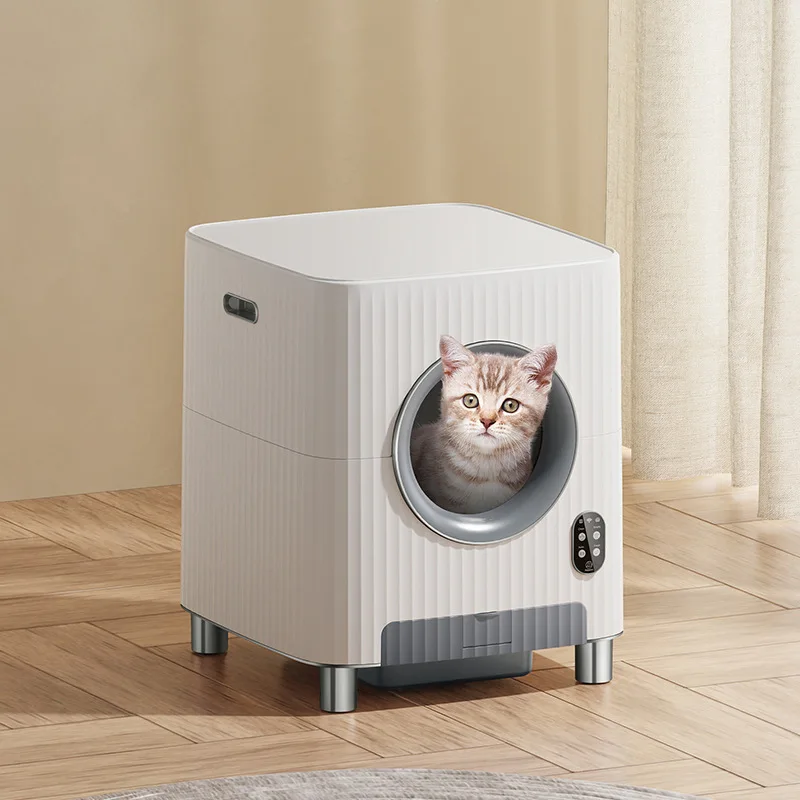When it comes to owning a cat, one of the most important considerations is providing them with a suitable litter box. Cats can be very particular about their litter box preferences, and choosing the right one can make a significant difference in their comfort and overall well-being. In this comprehensive guide, we will explore everything you need to know about selecting the best pet litter box for your cat.
- Why Choosing the Right Pet Litter Box Matters?
- How Many Pet Litter Boxes Should You Have?
- Choosing the Right Size Pet Litter Box
- How Big Should A Litter Box Be?
- Covered vs. Uncovered Pet Litter Boxes
- The Downside of Self-Cleaning Pet Litter Boxes
- Recommended Pet Litter Box Options
- Setting Up and Maintaining Your Pet Litter Box
- Conclusion
When it comes to owning a cat, one of the most important considerations is providing them with a suitable litter box. Cats can be very particular about their litter box preferences, and choosing the right one can make a significant difference in their comfort and overall well-being. In this comprehensive guide, we will explore everything you need to know about selecting the best pet litter box for your cat.
Why Choosing the Right Pet Litter Box Matters
Before diving into the specifics of choosing a litter box, it’s crucial to understand why this decision is so important. Cats are naturally clean animals and require a dedicated space to relieve themselves. Providing them with a suitable litter box ensures their physical and psychological well-being. Here are a few reasons why choosing the right litter box matters:
- Comfort: Cats prefer a litter box that is spacious and easy to maneuver in. A cramped or small litter box can cause stress and discomfort for your feline friend.
- Hygiene: A well-designed litter box helps maintain cleanliness by preventing litter scatter and odor issues. This is not only important for your cat’s health but also for the overall hygiene of your home.
- Accessibility: Cats of all ages and abilities should have easy access to their litter box. Consider the height and entry design of the box to accommodate kittens, senior cats, and those with mobility issues.
- Multiple Cats:If you have multiple cats, providing enough litter boxes is crucial to prevent territorial disputes and litter box avoidance issues.
How Many Pet Litter Boxes Should You Have?
The number of litter boxes you should have depends on the number of cats in your household. The general rule is to follow the “n+1 rule,” which means having one more litter box than the number of cats you have. For example, if you have two cats, you should have three litter boxes. Here’s why having multiple litter boxes is important:
- Avoiding Toileting Problems: Having too few litter boxes is a common cause of toileting problems in cats. Cats may avoid using a dirty or overcrowded litter box, leading to accidents outside the box.
- Territory Marking: Cats are naturally territorial animals. Providing multiple litter boxes allows them to have their own designated spaces, reducing the likelihood of territorial marking.
- Emergency Situations: In case of illness, injury, or mobility issues, having multiple litter boxes ensures that your cats always have access to a clean and accessible space.
Choosing the Right Size Pet Litter Box
One of the most important factors to consider when choosing a litter box is the size. Cats should have enough room to comfortably enter, turn around, and dig in the litter. Here’s how to determine the right size for your pet litter box:
- Length: The litter box should be at least as long as your cat, from their nose to the tip of their tail (when extended).
- Width: The width of the litter box should be at least as wide as your cat is long, including their tail.
- Depth: The depth of the litter box should provide enough litter for your cat to dig and cover their waste comfortably.
By choosing a litter box that meets these size requirements, you ensure that your cat has ample space to move around and maintain their natural digging behaviors.
How Big Should A Litter Box Be?
The height of the litter box sides is another crucial consideration, as it can affect your cat’s ability to enter and exit the box comfortably. Here are some guidelines based on your cat’s behavior and condition:
- Most Cats: For cats that do not spray or kick litter out of the box, a box with walls around 5-7 inches high is typically sufficient, especially if the box is large.
- Sprayers and Kickers: If you have a cat that sprays or kicks litter out of the box, you’ll need a litter box with higher sides to contain the mess. Look for boxes with walls around 8-12 inches high, ensuring that your cat can still enter and exit easily.
- Mobility Issues: If your cat is a young kitten or has arthritis or other mobility problems, opt for a litter box with at least one super low side, around 2.5-3.5 inches. This allows for easy entry and exit without causing discomfort.
Choosing the right height for your cat’s litter box sides ensures their comfort and prevents any unnecessary accidents or difficulties using the box.
Covered vs. Uncovered Pet Litter Boxes
One common debate among cat owners is whether to choose a covered or uncovered litter box. Both options have their pros and cons, and it ultimately comes down to your cat’s preference. Consider the following points when making your decision:
- Privacy: Covered litter boxes provide a sense of privacy for cats who prefer to do their business in seclusion.
- Odor Control: Covered litter boxes can help contain odors better than uncovered ones, making them a good choice for households where odor control is a concern.
- Accessibility: Some cats may find covered litter boxes uncomfortable or claustrophobic. Ensure that the opening is large enough and easily accessible for your cat.
- Cleaning: Covered litter boxes may require more frequent cleaning to maintain hygiene and prevent odors from building up.
It’s important to observe your cat’s behavior and preferences to determine whether they prefer a covered or uncovered litter box. If in doubt, you can offer both options and see which one your cat gravitates towards.
The Downside of Self-Cleaning Pet Litter Boxes
Self-cleaning litter boxes may seem like a convenient option, but they come with their own set of considerations. Here are a few reasons why you should think twice before opting for a self-cleaning litter box:
- Startling Effects: The automatic mechanisms of self-cleaning litter boxes can startle or scare some cats, leading to litter box aversion or anxiety.
- Specialized Litter Requirement: Many self-cleaning litter boxes require specific types of litter, which can be more expensive than regular litter options.
- Health Monitoring: Regular scooping of the litter box allows you to monitor your cat’s urine and feces for any signs of health issues. Self-cleaning boxes may hinder your ability to detect potential health concerns.
While self-cleaning litter boxes offer convenience, it’s essential to weigh the potential drawbacks and consider your cat’s comfort and well-being.
Recommended Pet Litter Box Options
Now that we’ve covered the essential factors to consider when choosing a pet litter box. For most cats, a large, plastic under-the-bed clothes storage box can be an excellent choice. Look for dimensions that provide enough space for your cat to move comfortably. Check out this 86L automatic litter box for multiple cats that offers a spacious design and easy cleaning.

Setting Up and Maintaining Your Pet Litter Box
Choosing the right litter box is just the first step; proper setup and maintenance are equally important. Here are some additional tips to ensure a clean and healthy litter box environment for your cat:
- Location: Place the litter box in a quiet and accessible area of your home. Avoid high-traffic areas or places with loud noises that may startle your cat.
- Litter Type: Experiment with different types of litter to find the one that your cat prefers. Most cats prefer unscented, clumping litter, but individual preferences may vary.
- Litter Depth: Maintain an appropriate litter depth of around 2-3 inches to allow your cat to bury their waste comfortably.
- Scooping Frequency: Scoop the litter box at least once a day to remove waste and prevent odors. Regular scooping also allows you to monitor your cat’s health.
- Regular Cleaning: Thoroughly clean the litter box and replace the litter every week. Use mild, unscented detergent to avoid any lingering smells that may deter your cat.
By following these guidelines, you can create a positive and hygienic litter box environment for your cat, promoting their overall well-being.
Conclusion
Choosing the best pet litter box for your cat requires careful consideration of their comfort, preferences, and specific needs. By providing a suitable litter box, you can ensure that your cat has a clean and comfortable space to relieve themselves. Remember to consider factors like size, height, and whether to opt for covered or uncovered boxes. Additionally, be cautious when considering self-cleaning options, as they may not be suitable for all cats. With the right litter box and proper maintenance, you can create a harmonious and hygienic environment for both you and your feline companion.
